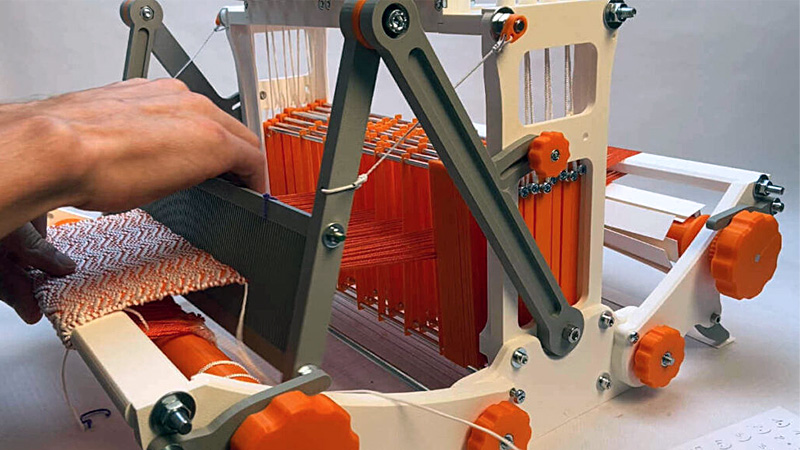The loom has been a transformative invention throughout history, shaping the textile industry from simple hand looms to complex, fully automated machines. Now, thanks to advancements in 3D printing, this age-old craft is being revitalized by modern makers. One such creator, [Fraens], has recently designed a unique 3D-printed table loom with eight shafts, offering a simpler yet innovative approach to weaving. This project is a fresh take on traditional looms, blending centuries of design knowledge with contemporary technology.
[Fraens], a longtime enthusiast of looms, has spent considerable time studying the countless designs that have evolved over more than 200 years. Drawing inspiration from these, he has crafted a more accessible version—a table loom that can be operated using levers to control the warp threads. Unlike larger, more complex looms, this 3D-printed model allows users to experiment with various weaving patterns easily, using different colors and sequences to create beautiful, intricate designs. [Fraens] provides guidance on how to adapt patterns meant for larger looms to this compact, lever-operated version on his website and in a detailed video tutorial.
This project is perfect for anyone interested in weaving or DIY technology. [Fraens]’ 3D-printed loom offers a new way to explore textile creation, making it both approachable and rewarding. To see this innovative loom in action and learn how to build your own, check out the video below.
















I would never do this but I think this a really cool. The design and building of the loom was awesome to see.
Tired as we may be of the Marble Machine iterations: after watching the build montage, my thoughts went to how one could add a sequencer / programming wheel.
Sequencer looks easy. I want to see an automated shuttle.
There’s a similar weaving system for socks (ie – tubes). It requires a set of special needles, which you can get online. I always thought that would make a good 3D printed project.
https://hackaday.com/2023/09/12/3d-printing-a-sock-knitting-machine/
That may be a circular knit machine, as many socks are knits. A lovely assortment of cams driving ranks of needles to open and close to hook precious loops. Lots of fun!
I have no experience with 3D printing. How much would it cost to print something like this?
The weaving term is a dobby or jacquard (depending on how you control it.) The jacquard system is where punch cards were invented (with each hole in a row lifting a heddle. Those two terms should get you a good head start.
I used an Ashford table loom like this, but I tend to prefer repeating patterns, and a treadle loom was welcome when my wife found one for us.
(also looms are CRAZY expensive new, so making your own is very viable.)
I have some Jhane Barnes shirts from the 90s that have some amazing patterns woven into them. They must have used something like this expanded for about 1000 threads.
The ultimate for weaving a pattern is the Jacquard Weave machine. Mr Jacquard made the first commercially successful physical computer.
Every ‘warp’ yarn being individually controlled allows any pattern in any sequence.
Now use multiple colors of yarn and multiple colors of filling for each insertion, and weave to ‘hide’ all undesired colors, amd you can weave pictures.
The jacquard looms used punched cards (of metal, wood, or paper) to convey these patterns to lifters. Lifters connect individual yarns to the hefty shedding mechanism. This means that a punched card directs the machine’s movements to direct weaving for patterns and pictures.
Not turing complete (as unweaving and ‘reading’ a weave wad not possible) but very much more computerized than an 8 harness loom. Which can also read a punch card to run the harnesses in different sequences.
I am a weaver. I have woven on every type of loom for decades. This is just a table loom. They have been around for as long as I can remember, there is absolutely nothing unique about it, you can buy one made out of wood with all the same features for between $500 and $800, usually. Eight shafts might be a little more. The only thing this loom has that the others don’t is that it’s made out of plastic. That’s it. There’s nothing innovative or new about it at all. Someone ought to sue these guys for false advertising!
It isn’t professing to be a new design of a loom; just a more DIY 3D print version.
The innovation comes from one’s ability to download and print this at home themselves.
Heh the table loom, the loom and weaving threads into fabric are obviously not an original idea here. That you can make one with a 3 d printer is cool though. Tldr what their final cost came out to but how does it compare to the cost of a table loom of comparable capacity?
yeah the part where they claim it innovates table looms by giving you levers to move the heddle really annoyed me. i assume that’s probably the fault of the author of the article and not the designer of the printed loom
It was obvious that the author had no clue whatsoever about weaving.
As a weaver, what bothered me was the number of joints in places where the threads are going to et stuck when under tension. Not that they may potentially go but definitely will go! Also that he didn’t fix the errors in the threading cross or preserve the cross at the other end to keep the warps absolutely in order. I was pleased that he chose to warp back to front, however.
Cool upgrade on old tech. I 3d printed a basic one with a few updates years ago. My daughters loved using it to learn to weave for about 4 weeks then stopped.
I can see myself turning my back on my PC and sitting down with one of these for a good long while.